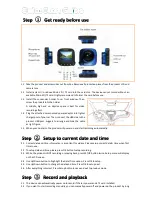
36
Camera Performance and Features
Linea ML Color Cameras
Image Response Uniformity
See the section Flat Field Category in Appendix A for GenICam features associated with this section
and how to use them
Relevant Features:
It is common to find an image with lower response at the edges of the camera’s field of view
compared to its center. This is typically the result of a combination of lens vignetting (cos
4th
) roll-
off and the beam structure of the illumination source. A more diffused light may reduce this roll-off
effect. However, if decreasing the lens aperture improves the edge roll-off, then barrel vignetting
(a shadow cast on the sensor by the focus helical or extension tubes) may also be present.
The camera can compensate for edge roll-off and other optical non-uniformities through flat field
calibration.
When performing Flat Field (PRNU) calibration, the camera should be imaging a front
illuminated white target or rear bright field illumination source. The optical setup should be
as per the inspection system, including lens magnification, aperture, and illumination
intensity, spectral content, plus illuminator beam structure.
Flat field calibration should be performed when the camera temperature has stabilized.
When the camera is commanded to execute a flat field calibration it will adjust all pixels to
have the same value as that of the peak pixel value or target level, as per the calibration
mode selected.
If flat field calibration is being set to a target level that is lower than the peak value and the
system gain is set to a low value, then it is possible that the sensor will maximize its output
before the camera’s output reaches 255 DN. This can be seen when a portion of the output
stops increasing before reaching 255DN with increasing illumination and the PRNU
deteriorates. This effect can be resolved by reducing the light level or exposure control time.
On completion of a flat field calibration, all pixels should be at their un-calibrated peak value or
target value. Subsequent changes in gain allow the user to make refinements to the operating
responsivity level.
Note that the best flat field calibration can be achieved by performing it at the mid DN level of the
working range used in the operation. Any flat field error associated with residual non-linearity in
the pixel will be halved as compared to performing a calibration at the peak value of the operating
range. A simple way of performing this is to reduce exposure time to half what is used in the
operation to get the mid DN level for flat field calibration. Once complete, return the exposure time
to its original setting.
Those areas of the image where high roll-off is present will show higher noise levels after flat field
calibration due to the higher gain values of the correction coefficients. Flat field calibration can only
compensate for up to an 8:1 variation. If the variation exceeds 8:1, then the line profile after
calibration will include pixels that are below the un-calibrated peak level.
Note: The Linea ML camera has many different modes of operation. It is strongly
recommended that the camera be flat fielded for the mode of operation that is intended.
Содержание ML Series
Страница 16: ...14 The Linea ML Color Camera Linea ML Color Cameras Mechanical Drawings ML FC 08K10T 00 R ...
Страница 17: ...Linea ML Color Cameras The Linea ML Color Camera 15 ML FC 16K04T 00 R ...
Страница 18: ...16 The Linea ML Color Camera Linea ML Color Cameras ML HC 16K10T 00 R ...
Страница 30: ...28 Camera Performance and Features Linea ML Color Cameras Figure 10 Image with incorrect scan direction ...
Страница 80: ...78 Declaration of Conformity Linea ML Color Cameras Declaration of Conformity ...
















































